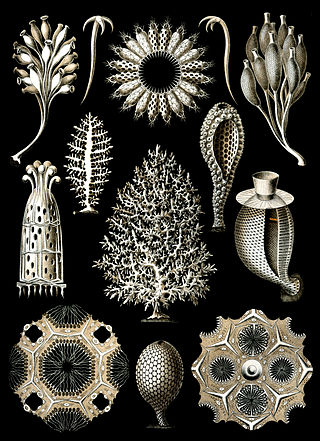
Archaeocyatha is a taxon of extinct, sessile, reef-building marine sponges that lived in warm tropical and subtropical waters during the Cambrian Period. It is believed that the centre of the Archaeocyatha origin is now located in East Siberia, where they are first known from the beginning of the Tommotian Age of the Cambrian, 525 million years ago (mya). In other regions of the world, they appeared much later, during the Atdabanian, and quickly diversified into over a hundred families.

Sponges or sea sponges are primarily marine invertebrates of the metazoan phylum Porifera, a basal animal clade and a sister taxon of the diploblasts. They are sessile filter feeders that are bound to the seabed, and are one of the most ancient members of macrobenthos, with many historical species being important reef-building organisms.

The calcareoussponges are members of the animal phylum Porifera, the cellular sponges. They are characterized by spicules made of calcium carbonate, in the form of high-magnesium calcite or aragonite. While the spicules in most species are triradiate, some species may possess two- or four-pointed spicules. Unlike other sponges, calcareans lack microscleres, tiny spicules which reinforce the flesh. In addition, their spicules develop from the outside-in, mineralizing within a hollow organic sheath.

Leucosolenida is an order of sponges in the class Calcarea and the subclass Calcaronea. Species in Leucosolenida are calcareous, with a skeleton composed exclusively of free spicules without calcified non-spicular reinforcements.

Demosponges (Demospongiae) are the most diverse class in the phylum Porifera. They include greater than 90% of all species of sponges with nearly 8,800 species worldwide. They are sponges with a soft body that covers a hard, often massive skeleton made of calcium carbonate, either aragonite or calcite. They are predominantly leuconoid in structure. Their "skeletons" are made of spicules consisting of fibers of the protein spongin, the mineral silica, or both. Where spicules of silica are present, they have a different shape from those in the otherwise similar glass sponges. Some species, in particular from the Antarctic, obtain the silica for spicule building from the ingestion of siliceous diatoms.

The siliceous sponges form a major group of the phylum Porifera, consisting of classes Demospongiae and Hexactinellida. They are characterized by spicules made out of silicon dioxide, unlike calcareous sponges.

Stromatoporoidea is an extinct clade of sea sponges common in the fossil record from the Middle Ordovician to the Late Devonian. They can be characterized by their densely layered calcite skeletons lacking spicules. Stromatoporoids were among the most abundant and important reef-builders of their time, living close together in flat biostromes or elevated bioherms on soft tropical carbonate platforms.

Minchinellidae is a family of calcareous sponges, members of the class Calcarea. It is the only family in the monotypic order Lithonida. The families Petrobionidae and Lepidoleuconidae have also sometimes been placed within Lithonida, though more recently they have been moved to the order Baerida. Thanks to their hypercalcified structure, minchinellids have a fossil record reaching as far back as the Jurassic Period.
Baerida is an order of sea sponges in the subclass of Calcaronea, first described in 2000 by Radovan Borojevic, Nicole Boury-Esnault and Jean Vacelet. Baerida contains four families; two of these families were formerly placed within the order Lithonida.

Homosclerophorida is an order of marine sponges. It is the only order in the monotypic class Homoscleromorpha. The order is composed of two families: Plakinidae and Oscarellidae.

Clathrina coriacea is a species of calcareous sponge belonging to the class Calcarea and family Clathrinidae. Species in the genus Clathrina are composed of calcium carbonate tube-like skeletons containing spicules. The sponge can be located in shallow waters widely distributed along North Atlantic coasts, as well as on other coasts.
Clathrina cylindractina is a species of calcareous sponge from Brazil. The species is named after the cylindrical-shaped actines the sponge possesses.
Ascandra izuensis is a species of sea sponge in the family Clathrinidae. The species is named after the Izu peninsula where the holotype was collected.

Spicules are structural elements found in most sponges. The meshing of many spicules serves as the sponge's skeleton and thus it provides structural support and potentially defense against predators.
Heteractinida is an extinct grade of Paleozoic (Cambrian–Permian) sponges, sometimes used as a class or order. They are most commonly considered paraphyletic with respect to Calcarea, though some studies instead argue that they are paraphyletic relative to Hexactinellida. Heteractinids can be distinguished by their six-pronged (snowflake-shaped) spicules, whose symmetry historically suggested a relationship with the triradial calcarean sponges.
Clathrina broenstedi is a species of calcareous sponge from the Weddell Sea. The species is named after Holger Brøndsted, a Danish sponge researcher. The only spicules present in this species are triactines.

Arturia is a genus of calcareous sponge in the family Clathrinidae which contains 14 species. It is named after Arthur Dendy, a prominent researcher of calcareous sponges. It was renamed Arturia in 2017 because the name Arthuria was already assigned to a genus of molluscs.
Clathrina arnesenae is a species of calcareous sponge from the Atlantic Ocean. It is named after Norwegian spongiologist Emily Arnesen (1867–1928).

Stellispongiida is an order of calcareous sponges, most or all of which are extinct. Stellispongiids are one of several unrelated sponge groups described as "inozoans", a name referring to sponges with a hypermineralized calcitic skeleton independent from their spicules. Stellispongiids have a solid skeleton encasing calcite spicules arranged in trabeculae. "Inozoans" and the similar "sphinctozoans" were historically grouped together in the polyphyletic order Pharetronida.












